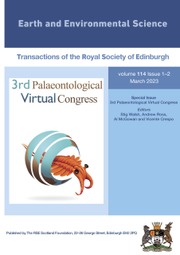Article contents
Origin of chemically zoned and unzoned cordierites from the South Mountain and Musquodoboit Batholiths, Nova Scotia
Published online by Cambridge University Press: 26 July 2007
Abstract
Textural relations and chemical zoning of cordierites in granites act as sensitive recorders of the conditions of their crystallisation history and underlying magma chamber processes. In this contribution, we present new data on texturally distinct and variably zoned cordierites from the late-Devonian, granitic South Mountain and Musquodoboit Batholiths, and infer the conditions of their formation. Using a combined textural (grain size, grain shape and inclusion relationships) and chemical (major element composition and compositional zoning) classification, we recognise the following six cordierite types: CG1/TT1, anhedral to subhedral macrocrysts with random inclusions and patchy normal zoning; CG2a/TT2, euhedral to subhedral macrocrysts with random inclusions and normal zoning; CG2b/TT2, euhedral to subhedral macrocrysts with random or oriented inclusions, and oscillatory zoning; CG3a/TT3, subhedral to euhedral microcrysts with no inclusions and reverse zoning; CG3b/TT4, euhedral macrocrysts with no inclusions and no zoning; and CG4/TT5, anhedral macrocrysts with random inclusions and normal zoning. The textural criteria suggest that these cordierites formed as a product of cotectic crystallisation from a melt, or as the result of a peritectic reaction involving country-rock material. The combined chemical and textural criteria suggest that: (1) normal zoning results from cotectic crystallisation during cooling, cotectic overgrowths on grains formed in a peritectic reaction with country-rock material, or cation exchange with a fluid; (2) oscillatory zoning results from cotectic crystallisation during variations in XMg of the silicate melt following magma replenishment; (3) reverse zoning results from crystallisation during pressure quenching; and (4) the unzoned cordierite results from cotectic crystallisation under fluid-rich conditions.
- Type
- Research Article
- Information
- Earth and Environmental Science Transactions of The Royal Society of Edinburgh , Volume 95 , Issue 1-2 , March 2004 , pp. 99 - 110
- Copyright
- Copyright © Royal Society of Edinburgh 2004
- 7
- Cited by


